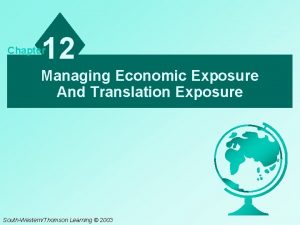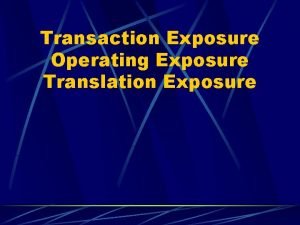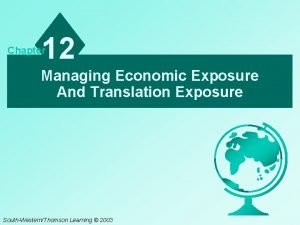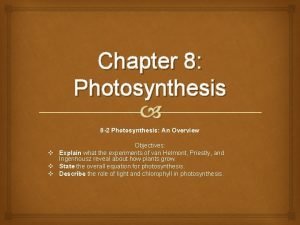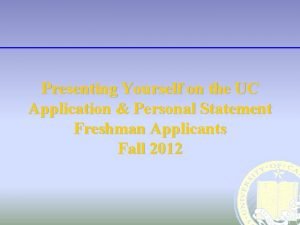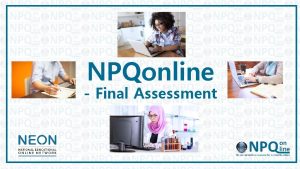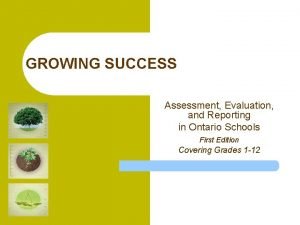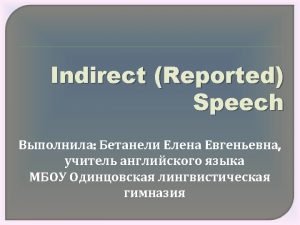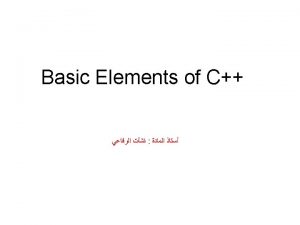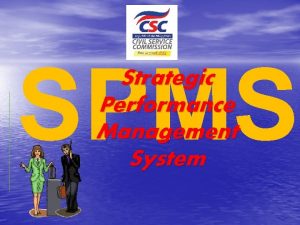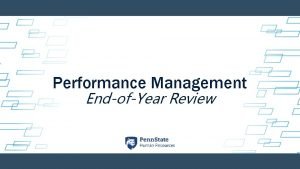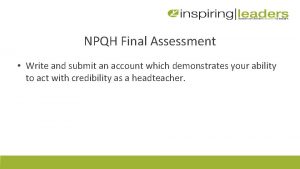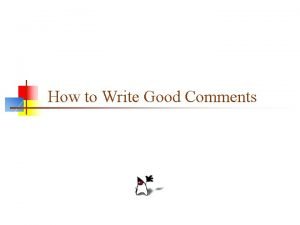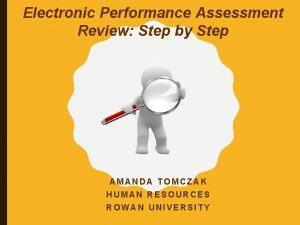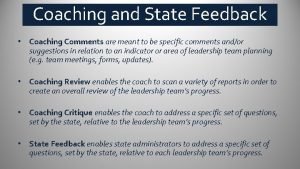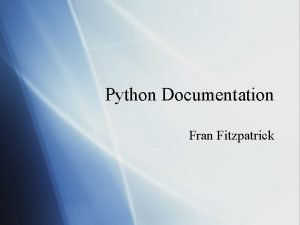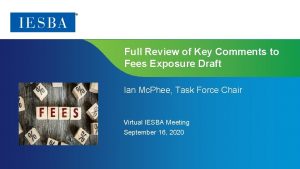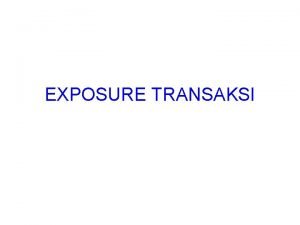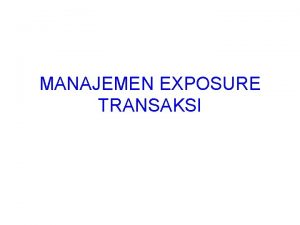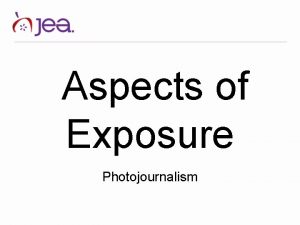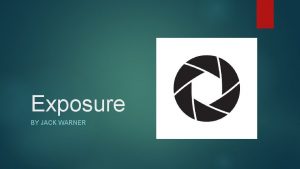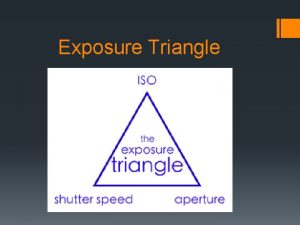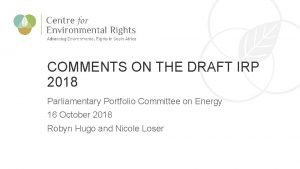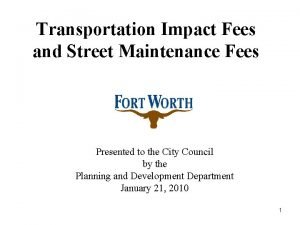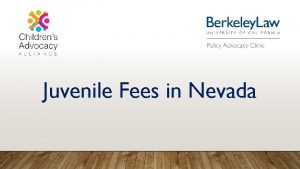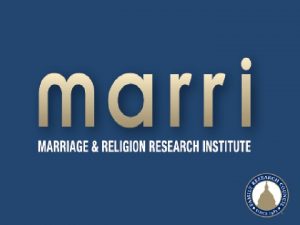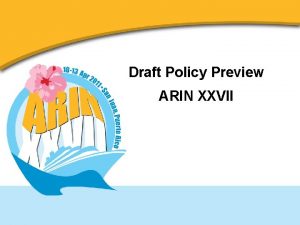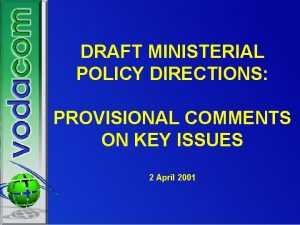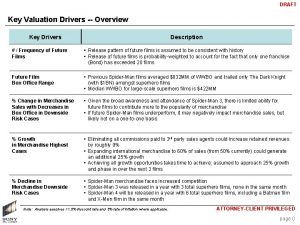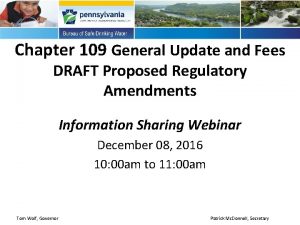Overview of Key Comments to Fees Exposure Draft



![Overview of Respondents STAK EHO LDER CATEGO RY Regulators # [CATEGO RY NAME] 10 Overview of Respondents STAK EHO LDER CATEGO RY Regulators # [CATEGO RY NAME] 10](https://slidetodoc.com/presentation_image_h2/7464f73b94468cd239fee80b67cd36e7/image-4.jpg)





















- Slides: 25

Overview of Key Comments to Fees Exposure Draft Ian Mc. Phee, Task Force Chair Virtual CAG Meeting September 10, 2020 Page 1 | Proprietary and Copyrighted Information

Objective of IESBA Session • To note observations and key issues raised by respondents to the Fees Exposure Draft (ED) • To advise of the Fees Task Force’s (TF) 1. Responses regarding how to address main comments 2. Proposed revisions to the fee-related proposals of the ED Page 2 | Proprietary and Copyrighted Information

Fees Exposure Draft and Comment Letters • • Released in January 2020 → with May 4 comment deadline – Previous coordination with NAS Task Force and with IAASB regarding overlapping issues – 15 specific questions in the ED for respondents Extension of comment deadline by a month due to COVID-19 – • 64 comment letters from different groups of stakeholders – including two Monitoring Group Members (IFIAR and IOSCO) IESBA received an overview of the key comments at its July 2020 session • The Board provided input to TF’s preliminary responses Page 3 | Proprietary and Copyrighted Information
![Overview of Respondents STAK EHO LDER CATEGO RY Regulators CATEGO RY NAME 10 Overview of Respondents STAK EHO LDER CATEGO RY Regulators # [CATEGO RY NAME] 10](https://slidetodoc.com/presentation_image_h2/7464f73b94468cd239fee80b67cd36e7/image-4.jpg)
Overview of Respondents STAK EHO LDER CATEGO RY Regulators # [CATEGO RY NAME] 10 Public Sector Organizations (PSO) 3 Preparers and TCWG 1 Independent National Standard Setters (INSS) 2 Professional Accountancy Organizations (PAOs) 33 Firms 12 Others 3 [CATEGO TEG RY NAME] ORY NAM E] [CATEGO RY NAME] [CATEGORY NAME] All comment letters available on the IESBA website Page 4 | Proprietary and Copyrighted Information

General Comments • Respondents generally supported IESBA to enhance the fee-related provisions in the International Independence Standards • Questions re timing of the project → Views that assessment of proposals is difficult without knowing impact of the new definition of PIE – • Views that proposals shift the Code from a principles-based Code to a rulesbased Code – v IESBA has committed to coordinate the effective dates of PIE Project with NAS and Fees projects to allow for appropriate transition periods Some concerns about the costs of implementation, and application of the proposed requirements creating too much administrative burden IFIAR and IOSCO – Support the direction of the proposals in the ED, but some jurisdictions have already gone beyond Page 5 | Proprietary and Copyrighted Information

Threats Created by Fees Paid by Audit Client v Self-interest (SI) threat to independence created when fees are negotiated with and paid by an audit client o Requirement for firms to determine whether such threats are at an acceptable level Majority of the respondents agreed with the proposals • Number of respondents (PAOs and firms) suggested that the inherent risk is the result of the "client relationship” – and not an issue specifically related to fees – and is already addressed by compliance with professional standards, including the Code • Risks are addressed through compliance with regulatory requirements and QM standards + the Code already includes requirements regarding evaluating threats – • Whether the determination is required for each engagement? Views that role of TCWG in appointing auditors and negotiating fees provides “checks and balances” to the audit client payer model Page 6 | Proprietary and Copyrighted Information

Threats Created by Fees Paid an Audit Client • TF believes that the Code should articulate and raise firms’ awareness that the SI threat exists Nevertheless, • – TF acknowledges that the audit client’s corporate governance structure and the firm’s compliance with regulatory requirements and professional standards help mitigate the SI threat arising from the audit client payer model – Involvement of TCWG in appointing the auditor and agreeing fees is a relevant factor in evaluating the level of threat TF believes that the inherent threats arising from the client relationship is a broader issue that is outside the remit of this project – • The Board supported the TF’s view and agreed to continue to address the matter of threats created by fees paid by an audit client in this project TF recognizes that Part 1 of the Code already requires the evaluation of threats as part of the conceptual framework – Removal of the proposed requirement in the light of the feedback received, and inclusion of application material that references the requirements in the conceptual framework Page 7 | Proprietary and Copyrighted Information

Matters for Consideration Do Representatives agree with the TF’s responses to comments raised regarding threats created by fees paid by an audit client? (See also proposed revisions in paragraphs 410. 4 A 1 to 410. 5 A 3 in Agenda Item D 2) Page 8 | Proprietary and Copyrighted Information

Impact of Other Services Provided to an Audit Client v Requirement that firms not allow the level of the audit fee to be influenced by the provision by the firm or a network firm of services other than audit to the audit client? General support that the audit fee is a standalone fee and the Code include relevant provisions • Concerns regarding the operability of the proposed requirement – Questions regarding enforceability and related documentation requirements – Suggestions for reconsidering the term “influenced” – Questions whether the proposed application material regarding the permissibility of considering specific cost savings achieved is contradicting the principle in the proposed requirement Page 9 | Proprietary and Copyrighted Information

Impact of Other Services Provided to an Audit Client • • TF believes the principle is appropriate and clear - Similar preexisting provisions in other jurisdictions - The extant Code uses the term “influence” in several other provisions TF proposes that the application material regarding the permissibility of considering specific cost savings be an exception to the requirement → To address contradiction comments regarding possible Page 10 | Proprietary and Copyrighted Information

Matters for Consideration Do Representatives agree with the TF’s responses to comments raised regarding the impact of other services provided to an audit client? (See also proposed revisions to paragraphs R 410. 6 to R 410. 7 in Agenda Item D 2) Page 11 | Proprietary and Copyrighted Information

Proportion of Fees v Guidance on determination of proportion of fees for services other than audit to audit fees ü Charged by both firm and network firms to the audit client; and ü Delivered to related entities of the audit client General support that large proportion of fees for services other than audit might create threats to independence • • Respondents, except regulators, supported that the Code does not include an exact threshold Suggestions for a more granular determination of services other than audit, i. e. audit-related service, especially services required by law or regulation to be performed by the auditor - • Not all services other than audit create the same level of threats to the firm’s independence Concerns about possible implementation challenges at network level and group level due to - Scope of related entities involved in the determination Processes might not exist to capture fees charged by network firms Page 12 | Proprietary and Copyrighted Information

Proportion of Fees • IESBA was of the view that a cap or exact threshold re. proportion of fees is not appropriate at a global level – • • The proportion of fees is determinable also at a network level → the calculation of the exact ratio of fees for services other than audit to the audit fee would often be a complex task TF is of the view that it would be impractical to create a definition of audit-related fees at global level – Nature of the services is already a relevant factor in evaluating the level of threat – As a clarification, TF proposes for firms to consider whether the service other than audit is mandated by law or regulation, as a factor TF acknowledges that level of the threats created by fees charged by network firms or delivered to related entities is generally expected to be lower – Relationship to the client of the related entities + the operating structure of the network are already factors → Now included in general section as those are relevant for the entire Section 410 Page 13 | Proprietary and Copyrighted Information

Matters for Consideration Do Representatives agree with the TF’s responses to comments raised regarding threats created by high proportion of fees for services other than audit to audit fees? (See also proposed revisions in paragraphs 410. 11 A 1 to 410. 11 A 3 in Agenda Item D 2) Page 14 | Proprietary and Copyrighted Information

Fee Dependency on Non-PIE Audit Clients v Including a threshold for firms to address threats created by fee dependency on a non-PIE audit client ü Whether the proposed threshold is appropriate? ü Whether the actions required to reduce threats are appropriate Number of stakeholders commented on the proposed threshold • Many respondents suggested to revert to a principles-based approach • Some regulators, INSS and others were of the view that the proposed threshold (30% in conjunction with 5 yrs) is too high; others found it too low → range of proposals on threshold – • Concerns that firms will perceive that such level of fee dependency is acceptable up to 5 years Concerns that, from public interest perspective, the burden created (i. e. external review) – especially in case of SMPs - may outweigh the benefit – Queries regarding the nature of the review performed by a PA outside of the firm Page 15 | Proprietary and Copyrighted Information

Fee-dependency on non-PIE Audit Clients • The proposal aims to create a consistent approach regarding the expectations in the case of non-PIE audit clients as well - • • • 30 percent threshold in conjunction with the 5 -years achieves some scalability, taking into account the different level of public interest, and allows enough time for newly established firms to deal with fee dependency In July, IESBA broadly supported retaining approach proposed in the ED TF believes that requiring an external review as a SG is a proportionate response Extant Code already includes “review of audit work performed” as a safeguard in many other circumstances - The review should be performed by a professional accountant outside of the firm given the level of fee dependency and the length of time → this ensures the necessary independence and skillset - This review is not equivalent to an EQR Page 16 | Proprietary and Copyrighted Information

Matters for Consideration Do Representatives agree with the TF’s responses to comments raised regarding the proposed provisions on fee dependency on a non-PIE audit client? (See also proposed revisions in paragraphs R 410. 15 to R 410. 17 in Agenda Item D 2. ) Page 17 | Proprietary and Copyrighted Information

Fee Dependency on PIE Audit Clients v Enhanced actions to reduce threats created by fee dependency in case of a PIE audit client v Requirement for firm to cease to be the auditor if fee dependency continues after 5 consecutive years Majority supported the enhanced provisions • Suggestions for reconsidering whether pre-issuance review is the only appropriate action to reduce threats to an acceptable level • Suggestions that IESBA consider a more principles-based approach • Some respondents (PAOs and firms) raised that having a definite period in a global code could have unintended consequences and create challenges to implementation • Several respondents felt that TCWG should have a more prominent role in the assessment of the firm’s independence and the actions taken in such circumstances Page 18 | Proprietary and Copyrighted Information

Fee Dependency on PIE audit clients • IESBA had previously agreed that if fee dependency continues in the second year of the audit engagement, only a review performed by a PA outside of the firm prior to the issuance of the audit opinion is an appropriate safeguard • IESBA also strongly supported that fee dependency on a PIE audit client cannot continue indefinitely – No safeguard capable of reducing the threats to an acceptable level after certain period of time → TF believes IESBA’s position in the ED still holds • Being mindful of possible market-specific issues, the proposal includes an exception to the requirement in special circumstances • Given the proposals regarding transparency of fee-related information, TCWG will have information to assess the extent of fee dependency on the client and are expected to participate in the decision making on how to address the fee dependency Page 19 | Proprietary and Copyrighted Information

Matters for Consideration Do Representatives agree with the TF’s responses to comments raised regarding the proposed provisions on fee dependency on a PIE audit client? (See also proposed revision in paragraphs R 410. 18 to 410. 21 A 1 in Agenda Item D 2) Page 20 | Proprietary and Copyrighted Information

Transparency of Fee-related Information of PIEs v Requirement regarding disclosure of fee-related information of a PIE audit client to TCWG and to the public Support that transparency can serve to better inform views and decisions about the auditor’s independence • Support for enhanced provisions regarding communication of fee-related information of PIEs to TCWG • Support from some regulators for proposals on public disclosure • However, many concerns (from INSS, spread of PAOs and majority of firms) regarding the requirement for firms to disclose fee-related information – Requiring such disclosure is outside of the remit of the Code and should be addressed by laws and regulations – Disclosure is the client’s responsibility and should not be imposed on the auditor through the Code – Several concerns regarding the disclosure of fee-related information in the audit report and disclosure of information about audit fees paid or payable to other firms outside of the network Page 21 | Proprietary and Copyrighted Information

Transparency of Fee-related Information of PIEs • In July IESBA supported that the Fees Project aims to provide global transparency in the Code • TF agrees with comments that disclosure of the fee-related information to the public is mainly the responsibility of the client • The revisions to the provisions on enhanced transparency to the public aim at: • 1. Supporting the disclosure by the audit client based on national laws and regulations 2. If laws and regulations do not require disclosure by the client, the firm should discuss first with TCWG the benefit of the disclosure by the client to stakeholders 3. To the extent the client declines to disclose the fee-related information, the firm should disclose as a last resort Revisions provide a more flexible approach for firms to achieve such transparency – Proposals require the disclosure of audit fees paid or payable only to the firm and network firms – There are more examples on a suitable location for disclosure by the firm • Possible ways of disclosure are in line with IAASB’s latest proposals regarding communication with external parties in proposed ISQM 1 Page 22 | Proprietary and Copyrighted Information

Matters for Consideration Do Representatives agree with the TF’s responses to comments raised regarding transparency of feerelated information? (See also proposed revisions in paragraphs 410. 26 A 1 to 410. 28 A 2 in Agenda Item D 2) Page 23 | Proprietary and Copyrighted Information

Next Steps • September 2020 – IESBA meeting - Full analysis of comments to Fees ED and first-read of proposed revisions • October 2020 – Targeted outreach to stakeholders, such as: • • • Forum of Firms (deep-dive session) IESBA National Standard Setters IFAC SMPC • December 2020 – IESBA meeting - Approval of Final Text Page 24 | Proprietary and Copyrighted Information

The Ethics Board www. ethicsboard. org Page 25 | Proprietary and Copyrighted Information
 Object of draw frame
Object of draw frame Exposure draft adalah
Exposure draft adalah Managing economic exposure and translation exposure
Managing economic exposure and translation exposure Operating exposure adalah
Operating exposure adalah Transaction exposure vs economic exposure
Transaction exposure vs economic exposure Managing economic exposure and translation exposure
Managing economic exposure and translation exposure Business model
Business model Business model canvas tripadvisor
Business model canvas tripadvisor 8-2 photosynthesis an overview
8-2 photosynthesis an overview The two rows of elements that seem to be disconnected
The two rows of elements that seem to be disconnected Additional comments uc application
Additional comments uc application Performance appraisal of international employees
Performance appraisal of international employees Integrity appraisal comments
Integrity appraisal comments Npqonline
Npqonline Growing success document
Growing success document Remarks example
Remarks example C++ style comments
C++ style comments What is spms in government
What is spms in government Housekeeping items meeting
Housekeeping items meeting Curriculum-led budget template npqh
Curriculum-led budget template npqh Write your comments
Write your comments Expectations for unit and ratee examples
Expectations for unit and ratee examples Coaching review comments
Coaching review comments What went well comments
What went well comments Pydoc comments
Pydoc comments What are the different events in triggers mcq
What are the different events in triggers mcq


